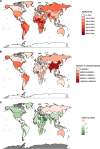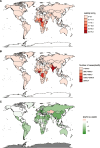Maternal sepsis and other maternal infections: Global Burden from 1990 to 2021
- PMID: 40420020
- PMCID: PMC12105181
- DOI: 10.1186/s12884-025-07722-w
Maternal sepsis and other maternal infections: Global Burden from 1990 to 2021
Abstract
Background: Maternal sepsis and other maternal infections (MSMIs) pose significant global health challenges, leading to considerable morbidity and mortality. Understanding the global burden of MSMIs is essential for resource allocation and the development of targeted prevention and treatment strategies.
Objectives: To analyse the global burden of MSMIs from 1990 to 2021, and identify disparities across age groups, regions, countries, and socio-demographic indexes (SDIs).
Methods: Data were sourced from the Global Burden of Disease Study (GBD) 2021, stratified by age, SDI level, region, and country. The age-standardized incidence and death rates in 2021, along with their estimated annual percentage changes (EAPCs) from 1990 to 2021, were used to measure the current burden and temporal trends.
Results: In 2021, the numbers of MSMIs incidence and deaths were estimated at 19.05 million (95% [uncertainty interval] UI: 14.61 to 24.09 million) and 17.67 thousand (95% UI: 14.63 to 21.19 thousand), respectively, with age-standardized incidence and death rates of 243.51 (95% UI: 186.01 to 307.48) and 0.22 (95% UI: 0.18 to 0.27) per 100,000 populations. Age-standardized incidence and death rates peaked in the 20-24 age group. From 1990 to 2021, the age-standardized incidence and death rates of MSMIs decreased, with EAPCs of -1.20 (95% [confidence interval] CI: -1.26 to -1.13) and -2.49 (95% CI: -2.95 to -2.03) respectively. The largest increase in the age-standardized incidence rate in 21 GBD regions was found in Australasia (EAPC: 0.70; 95%CI:0.52 to 0.89), and the largest increase in the age-standardized death rate was found in Oceania (EAPC:0.70; 95%CI: 0.51 to 0.88). The largest increase in the age-standardized incidence rate in 204 countries was found in Australia (EAPC:1.80; 95%CI:1.40 to 2.20), and the largest increase in the age-standardized death rate was found in Kazakhstan (EAPC:3.42; 95%CI: 2.56 to 4.29). Both the age-standardized incidence (R = -0.76, P < 0.001) and death rates (R = -0.65, P < 0.001) show a negative correlation with SDI levels.
Conclusions: This study reveals a decreasing trend in the global burden of MSMIs, yet disparities persist, particularly in 20-24 age group, lower SDI regions,and regions and countries with increasing burdens. These findings underscore the need for targeted interventions to address the remaining challenges in MSMIs, especially in more vulnerable populations.
Keywords: Deaths; Global Burden of Disease Study; Incidence; Maternal sepsis and other maternal infections.
© 2025. The Author(s).
Conflict of interest statement
Declarations. Ethics approval and consent to participate: Not applicable. Consent for publication: Not applicable. Competing interests: The authors declare no competing interests.
Figures





Similar articles
-
Trends and predictions of maternal sepsis and other maternal infections among women of childbearing age: a systematic analysis for the global burden of disease study 2019.Front Public Health. 2024 Oct 23;12:1428271. doi: 10.3389/fpubh.2024.1428271. eCollection 2024. Front Public Health. 2024. PMID: 39507668 Free PMC article.
-
Burden and trend of maternal sepsis and other maternal infections in BRICS countries from 1990 to 2021.BMC Pregnancy Childbirth. 2025 May 20;25(1):591. doi: 10.1186/s12884-025-07694-x. BMC Pregnancy Childbirth. 2025. PMID: 40394566 Free PMC article.
-
The global, regional, and national burdens of maternal sepsis and other maternal infections and trends from 1990 to 2021 and future trend predictions: results from the Global Burden of Disease study 2021.BMC Pregnancy Childbirth. 2025 Mar 14;25(1):285. doi: 10.1186/s12884-025-07409-2. BMC Pregnancy Childbirth. 2025. PMID: 40087648 Free PMC article.
-
Global, regional, and national epidemiology of ischemic heart disease among individuals aged 55 and above from 1990 to 2021: a cross-sectional study.BMC Public Health. 2025 Mar 12;25(1):985. doi: 10.1186/s12889-025-22193-6. BMC Public Health. 2025. PMID: 40075403 Free PMC article.
-
Global, regional, and national burdens of leukemia from 1990 to 2017: a systematic analysis of the global burden of disease 2017 study.Aging (Albany NY). 2021 Apr 4;13(7):10468-10489. doi: 10.18632/aging.202809. Epub 2021 Apr 4. Aging (Albany NY). 2021. PMID: 33820874 Free PMC article.
References
-
- Filetici N, Van de Velde M, Roofthooft E, Devroe S. Maternal sepsis. Best Pract Res Clin Anaesthesiol. 2022;36(1):165–77. 10.1016/j.bpa.2022.03.003. Epub 2022 Mar 30 PMID: 35659952. - PubMed
-
- Say L, Chou D, Gemmill A, Tunçalp Ö, Moller A-B, Daniels J. A Metin Gülmezoglu, Marleen Temmerman, Leontine Alkema; Global causes of maternal death: a WHO systematic analysisThe Lancet. Global health. 2014;2(6):e323–33. 10.1016/S2214-109X(14)70227-X. - PubMed
-
- GBD 2021 Diseases and Injuries Collaborators. Global incidence, prevalence, years lived with disability (YLDs), disability-adjusted life-years (DALYs), and healthy life expectancy (HALE) for 371 diseases and injuries in 204 countries and territories and 811 subnational locations, 1990–2021: a systematic analysis for the Global Burden of Disease Study 2021. Lancet. 2024;403(10440):2133–2161. 10.1016/S0140-6736(24)00757-8. Epub 2024 Apr 17. PMID: 3864 2570; PMCID: PMC11122111. - PMC - PubMed
MeSH terms
LinkOut - more resources
Full Text Sources
Medical

